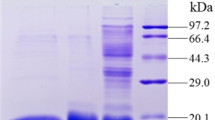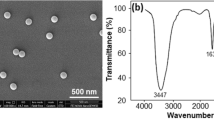Abstract
Lead (Pb2+) is a well-known highly toxic element, and Spirodela polyrrhiza is one of the hydrophytes most sensitive to Pb2+, which might be highly toxic to photosynthesis. However, the mechanism by which Pb2+ inhibits energy transfer and conversion efficiency remains unclear. Here, we report the effects of Pb2+ on the secondary structure and function of photosystem II (PS II) of S. polyrrhiza using spectral methods. We found that Pb2+ accumulated in PS II and damaged its secondary structure, decreased the absorbance of visible light, inhibited energy transfer among amino acids within the PS II protein–pigment complex, and reduced energy transport from tyrosine residue to chlorophyll a. Taken together, Pb2+ exposure damaged the structure and function of S. polyrrhiza PS II.






Similar content being viewed by others
References
Foy CD, Chaney RL, White MC (1978) The physiology of metal toxicity in plants. Annu Rev Plant Physiol 29:511–566
Reed RH, Gadd GM (1990) Metal tolerance in eukaryotic and prokaryotic algae. In: Shaw AJ (ed) Heavy metal tolerance in plants: evolutionary aspects. CRC, Boca Raton
De Filippis LF, Pallaghy CK (1992) Heavy metals: sources and biological effects. In: Rai LC, Gaur JP (eds) Phycological perspectivies of water pollution. E. Schweizerbart Verlag, Stuttgart
Luo LX, Sun TY (1998) Effect of cadmium-surfactant combined pollution on physiological characteristic of wheat leaf. Chin J Appl Ecol 9(1):95–100, (in Chinese)
Qin TC, Wu YS, Wang HX, Li QR (1998) Effect of cadmium, lead and their interactions on the physiological and ecological characteristics of root system of Brassica chinensis. Acta Ecol Sin 18(3):320–325, (in Chinese)
Luo LX, Sun TY (1998) Effect of cadmium stress on lipid peroxidation in wheat leaves. China Environ Sci 18(1):72–75, (in Chinese)
Zhou CF, Wu GR, Shi GX, Lu CM (2001) The role of antioxidant systems in Cu2+ stress resistance in Spirrodela polyrhiza. Acta Bot Sin 43:389–394
Yan SZ (1983) The illustrated handbook of high aquatic plant in China. Science, Beijing, p 294
Miles CD, Brandle JR, Daniel DJ, Chu-Der O, Schnare PD, Uhlik DJ (1972) Inhibition of photosystem II in isolated chloroplasts by lead. Plant Physiol 49:820–825
Parys E, Romanowska E, Siedlecka M, Poskuta JW (1998) The effect of lead on photosynthesis and respiration in detached leaves and in mesophyll protoplasts of Pisum sativum. Acta Physiol Plant 20:313–322
Shearan IS, Singh R (1993) Effect of heavy metals on photosynthesis in higher plants. In: Abrol YP, Mohanty P, Govindjee (eds) Photosynthesis: photoreactions to plant productivity. Kluwer, Dordrecht, pp 451–468
Ernst WHO, Nielssen HGM, Ten Bookum WM (2000) Combination toxicology of metal- enriched soils: physiological responses of a Zn- and Cd-resistant ecotypes of Silene vulgarison polymetallic soils. Environ Exp Bot 43:55–71
Sinha SK, Srivastava HS, Tripathi RD (1993) Influence of some growth regulators and cations on inhibition of chlorophyll biosynthesis by lead in maize. Bull Environ Contam Toxicol 51:241–246
Van Assche JA, Clijsters H (1990) Effects of heavy metals on enzyme activity in plants. Plant Cell Environ 13:195–206
Wu X, Liu C, Qu CX, Huang H, Liu XQ, Chen L, Su MY, H, ong FS (2008) Influences of PbCl2 on the nitrogen metabolism of spinach. Biol Trace Element Res 121:258–265
Wu X, Huang H, Liu XQ, Chen L, Liu C, Su MY, Hong FS (2008) Oxidative stress induced by lead in chloroplast of spinach. Biol Trace Elem Res. doi:10.1007/s12011-008-8195-7
Kupper H, Kupper F, Spiller M (1996) Environmental relevance of heavy metal substituted chlorophylls using the example of water plants. J Exp Bot 47:259–266
Wu X, Liu C, Qu CX, Huang H, Liu XQ, Chen L, Hong FS (2008) Effects of lead on activities of photochemical reaction and key enzymes of carbon assimilation in spinach chloroplast. Biol Trace Elem Res. doi:10.1007/s12011-008-8196-6
Wu X, Hong FS, Liu C, Su MY, Zheng L, Gao FQ, Yang F (2008) Effects of Pb2+ on energy distribution and photochemical activity of spinach chloroplast. Spectrochim Acta Part A 69:738–742
Meider H (1984) Class experiments in plant physiology. George Allen and Unwin, London, pp 72–74
Kuwabara T, Murata N (1982) Inactivation of photosynthetic oxygen evolution and concomitant release of three polypeptides in the photosystem II particles of spinach chloroplasts. Plant Cell Physiol 23:533–539
Arnon DI (1949) Copper enzymes in isolated chloroplasts. Polyphenol oxidase in Beta vulgaris. Plant Physiol 24:1–15
Perczel A, Park K, Fasman GD (1992) Analysis of the circular dichroism spectrum of proteins using the convex constraint algorithm: A practical guide. Anal Biochem 203:83–93
Du LF, Tang XS, Liang HG, Kuang TY (1991) The Comparison of water-splitting activity, DCIP photoreduction activity and some property of photosystem II particles from different plants. Acta Phytophysiol Sin 17(4):342–348, (in Chinese)
Du LF, Tang XS (1992) Isolation and properties of oxygen-evolving photosystem II reaction center complex. Acta Phytophysiol Sin 18(1):17–23, (in Chinese)
Hong FS (2004) Effect of Eu3+ on phtosystem II spectral characteristics from spinach. Biol Trace Elem Res 100:186–196
Su MY, Wu X, Liu C, Qu CX, Liu XQ, Chen L, Huang H, Hong FS (2007) Promotion of energy transfer and oxygen evolution in spinach photosystem II by nano-anatase TiO2. Biol Trace Elem Res 119(2):183–192
Zhao NM, Zhou HM (2000) Biophysics. China Higher Education Press and Springer, Beijing, pp 299–309, (in Chinese)
Barber J, Chapman DJ, Telfer A (1987) Characterization of a PS II reaction center isolated from the chloroplasts of Pisum sativum. FEBS Lett 220:67–73
Seibert M, Picorel R, Rubin AB, Connoly JS (1988) Spectral, photophysical, and stability properties of isolated photosystem II reaction center. Plant Physiol 87:303–306
Guo YJ (1983) In fluorescence technique and its application to molecular biology. Science, Beijing, p 188, (in Chinese)
Buchanan BB, Gruissem W, Jones RL (2002) Biochemistry and molecular biology of plants. Science Press, American Society of Plant Physiologists, Beijing, pp 610–616
Acknowledgments
This work was supported by the National Natural Science Foundation of China (grant no. 30470150, 30800068).
Author information
Authors and Affiliations
Corresponding author
Rights and permissions
About this article
Cite this article
Qufei, L., Fashui, H. Effects of Pb2+ on the Structure and Function of Photosystem II of Spirodela polyrrhiza . Biol Trace Elem Res 129, 251–260 (2009). https://doi.org/10.1007/s12011-008-8283-8
Received:
Accepted:
Published:
Issue Date:
DOI: https://doi.org/10.1007/s12011-008-8283-8




